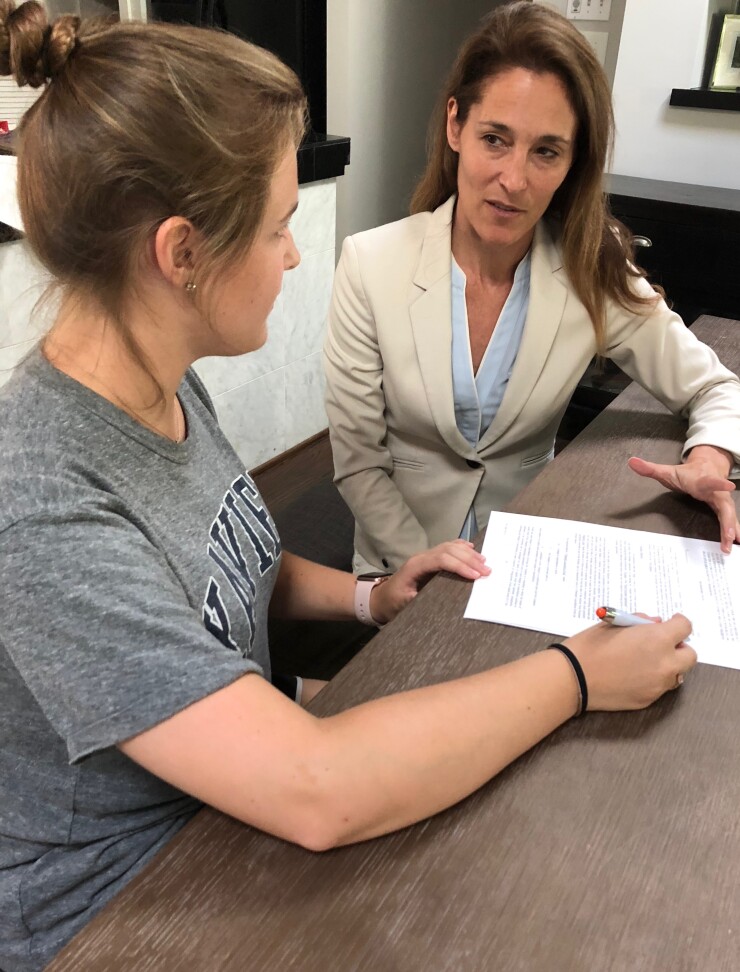Harvard MBAs who want to refinance their student debt have numerous options, including the online lenders SoFi and CommonBond. Ivy Leaguers who need a loan to get through college also have choices, including Discover and Wells Fargo.
But low- or moderate-income students who do not have relatives with sound credit who can co-sign have few options for obtaining the financial help they need to complete college. Many of them are women, who hold nearly two-thirds of outstanding student debt in the U.S. — almost $900 billion as of mid-2018.
“Many students are confronted with a gap between the cost of funding and student aid,” noted Dan Kimerling, co-founder of Deciens Capital and a former executive at Silicon Valley Bank. “For most people, their parents pay for it or they co-sign with their parents. If your parents can’t pay for it, if you can’t co-sign, what do you do? With some of these kids, the difference between graduating and not graduating is $3,000.”
Enter Funding University, a fintech startup in Atlanta.
Jeannie Tarkenton, founder and CEO, had a college roommate who was doing well at school but, because of a small shortfall in money, was going to have to drop out. The roommate was fortunate that several alumni came together to group-fund a loan to her.

“That was my personal touchstone, seeing that happen,” Tarkenton said.
Tarkenton went on to do corporate philanthropic work “where a ton of money was being pushed into this same problem of college completion,” she said.
She began to think about a for-profit, market-driven solution to the problem.
The anti-SoFi
Tarkenton quickly realized she did not want to go after the super-prime market that is SoFi's specialty.
“SoFi works because Stanford Business School risk is something people viscerally understand,” Tarkenton said. “But in the market, the real need is among low-income students. The bulk of our borrowers are solid earners and employed, but they are not behaviorally likely to be Ivy League MBA types.”
The majority of Funding University’s borrowers are students at city and state universities. Half have family income below $40,000.
Funding University for now is focused on students who graduate from four-year accredited colleges in five years or less, which is what it considers on-time graduation. Historic data shows that this cohort tends to have stable loan repayment rates with a median default rate of about 5.5%.
“We will expand outside of that as we grow," Tarkenton said. "There’s a lot more need, and a lot of people don’t go to school full time."
In its underwriting, the company considers class attendance rate and other data points about students’ progress in predicting whether they will graduate in time.
Where many student lenders consider a school’s average student loan default rate, which disadvantages minority and for-profit schools that tend to have high default rates, Funding University says it makes this criterion only a small factor in its underwriting.
“We underwrite to the student, not to the environment,” Tarkenton said. “We’re not penalizing a student who is at a school where a lot of his or her classmates default. We look at the student’s behaviors and academic record.”
Funding University considers the average earnings of the student’s planned profession in the first, fifth and tenth years. It seeks a debt-to-projected-income ratio of less than 20%. So if engineers are expected to make $50,000 their first year of working, their debt load would be no more than $10,000 each that year.
The money is also given directly to the student, not to the school.
This is unusual, because generally the lender wants to make sure the money is not being used for noneducational purposes. If students have complete discretion over the money and waste it away, they could find themselves in a permanent hole, as they cannot use bankruptcy to discharge the debt.
Tarkenton expects to refine the underwriting model as the company learns more about majors, earnings and debt.
“In specialty finance, you start with a meat cleaver and go in with available data around how you can underwrite and sign the less risky students or consumers in a block that a bank won’t touch,” she said. “Then as we learn we can begin to see default rates and apply machine learning, so it becomes a credit model that’s learning from itself.”
Funding University’s loan rate for now is 11.49%; there are plans to offer a 9.99% rate loan to a segment of students.
The company is lending in 20 states. It has a lending license in California and plans to pursue licenses in six other states next year. It’s considering forming a loan originating relationship with a bank like Cross River Bank, which has made a business out of working with online lenders.
“Most of our portfolio are CRA-eligible paper,” Tarkenton noted, referring to the Community Reinvestment Act. “We’re hoping and seeking to work with banks who have a shared interest, whether it’s mission-driven or to meet their CRA requirements.”
Tarkenton expects the company to lend between $5 million and $10 million to about 600 customers in 2018.
“We’re right in the middle of loan season" of June through September, she said. “We’ve had 7,600 students apply so far.”
The front-end loan prequalification process is completely automated.
At the next stage of application, know-your-customer reviews and underwriting, humans get involved. Three retired bankers review applications, rescore students and verify information.
“As we grow in our next stage, we will automate some of those back-office functions,” Tarkenton said. “But we’ll always have humans be part of the underwriting.”
Fixing student loans
Observers agree there is a crying need for new, consumer-friendly student loan offerings.
“Thirty years ago, most of this was a public benefit,” said Garry Reeder, vice president of innovation and policy at the Center for Financial Services Innovation. “You went to a state school, there was very little borrowing, and most of the school was paid for by taxpayers. Now we’ve flipped it to where if you go to school and you can’t afford an education, instead of that being subsidized, you take on a loan. ... At the end of the day a government benefit turns into a private debt obligation."
And the gap between what the government is willing to provide for loans is not keeping up with what people need, Reeder said.
“This is a space that really has reshaped American opportunity and reshaped people’s financial health in ways that people complain about it today and talk about it," he said. "But when you look really closely, it’s a large public policy conundrum that needs to be solved, because it’s hurting millions of people.”
Another company trying to solve these problems, Reeder said, is College Ave Student Loans in Wilmington, Del.
College Ave’s founder wasn’t available for an interview by press time; a spokeswoman answered a few questions. The company offers five- to 15-year fixed- and variable-rate loans to undergraduates, graduates and parents. The loans are for borrowers with a strong credit history and often there’s a co-signer. Underwriting is based on the borrower's credit score and history, annual income and debt-to-income ratio.
Another startup, SixUp, is currently working out of the Center for Financial Services Innovation's innovation lab.
“What they are trying to do is monitor and support people throughout this process,” Reeder said. “One of the problems with student loans is you go to school then suddenly, six to nine months after you graduate, some servicer you never heard of sends you a letter and says you owe this amount of money every month. You can imagine for people who are first-generation college or find it difficult to get employment after school, suddenly they’ve gone from something that felt free to suddenly people are asking you for substantial amounts of money that you don’t have the cash flow to meet.”
SixUp identifies what it calls “future prime” students based on how they are doing in school, what school they go to, and their major. The company refinances the students’ loans to 7% or 8% and supports them with summer internships and help finding a job after they graduate.
“Even though that’s an investment, that makes the paper, which is all the investors care about, a much less risky piece of paper,” Reeder said.
Editor at Large Penny Crosman welcomes feedback at penny.crosman@sourcemedia.com.




